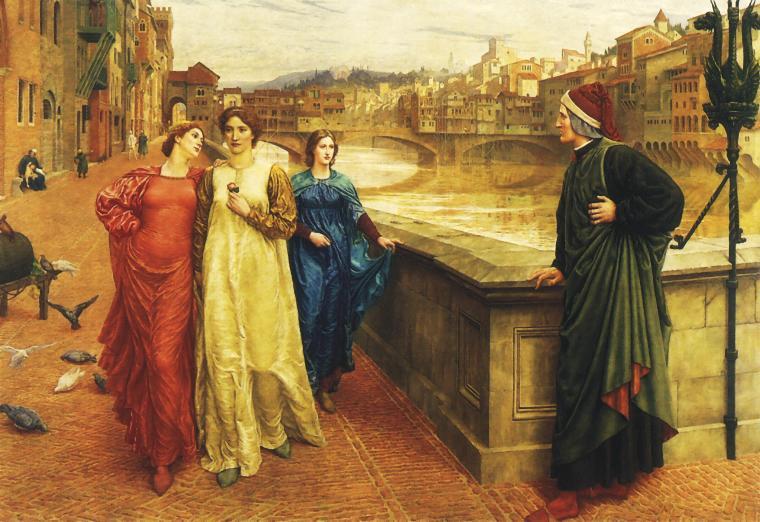What could a 700-year-old medieval poem possibly have to say to us about the nature of suffering that would be relevant in the year 2025? Quite a lot, as it turns out.
“The Divine Comedy,” written by Dante Alighieri in the early 14th century, tells of the pilgrim’s spiritual journey through the realms of the afterlife: Hell, Purgatory, and Heaven. Dante’s towering poem plunges to the harrowing depths of Hell and surges to the luminous pinnacles of Heaven, encompassing the full range of human emotion and experience, encapsulating the entirety of the human and divine drama.

Dante Alighieri, detail from Luca Signorelli's fresco in the Chapel of San Brizio, Orvieto Cathedral. JoJan/CC BY-SA 3.0
As Aldo Bernardo and Anthony Pellegrini note in their book “Companion to Dante’s Divine Comedy,” Dante sought to synthesize a “complete vision” of all that exists, the universe and humanity’s place in it, drawing together all things in a harmonious and ordered whole, bound by love. Most of what he wrote in the 14th century applies with equal force today; we continue to live out a psychological and spiritual drama whose fundamental underpinnings remain unchanged. As long as human nature endures, suffering will remain in the world and we will grapple with how to make sense of it.
Dante can assist us, teaching us little by little the mysterious ways of suffering and how its presence in our life is a necessary catalyst to our growth and perfection as human beings.
Suffering in Hell
“The Divine Comedy” is a poem fraught with pain in the beginning. After the famous opening in which Dante finds himself in “a gloomy wood, astray,” he is led by the Roman poet Virgil into the caverns of Hell. There, he sees the suffering, torments, and despair that are the consequences of unrepentant sin.
Dante holding his “Divine Comedy,” next to the entrance to Hell, the seven terraces of Mount Purgatory and the city of Florence, with the spheres of Heaven above, 1465, in a fresco by Domenico di Michelino. Cathedral of St. Mary of Fiore, Florence. Public Domain
As Dante and Virgil descend through ring after ring of Hell, witnessing souls blown about in storms, pinioned by demons’ pitchforks, and stuck upside down in steaming hot holes, Dante is brought face-to-face with the suffering of those who have refused to change. The sinners in the “Inferno” undergo a fruitless and endless experience of pain as punishment for their sins. Those in Hell refuse to repent of their wayward ways; the suffering brings about no change or improvement in these unwilling sufferers.
Critics generally agree that Dante’s poem can be read on multiple levels: On one level, it’s the account of a journey through the afterlife. But allegorically, it also tells of the soul’s journey to God in this life, the process of spiritual conversion and maturation.
Through powerful poetic imagery, Dante points to the fact that—even here on earth—the sufferings of the wayward soul are often self-imposed. Hemmed in by self-will, the world of the sinner continually contracts until he is literally encased in his own evil and misery. This is just the way Dante depicts Satan in the poem—as a monstrous figure locked in sheets of ice at the earth’s very core. The ice has formed due to the frigid gusts thrown up by the monster’s endless beating of his batlike wings. In his unbridled pride and fruitless attempt to rise above God himself, Satan has literally created his own prison.
Reflecting on these considerations in a metaphorical and earthly sense, we see the wisdom and truth of what Dante’s poem proposes: The experience of suffering depends greatly on the attitude of the sufferer, and, in some cases, the suffering may even be self-inflicted due to a refusal to give up a harmful, damaging, or irrational way of life.
But the punitive suffering of Hell is not the only type of suffering Dante presents. In the second part of the poem, the “Purgatorio,” suffering is not punitive but medicinal. The entire tenor of the poem changes with the attitude of the sufferers Dante encounters. Their reaction to suffering is completely different in this realm of light and hope compared to the sulfurous recesses of the inferno.
The Suffering in Purgatory

Purgatory, 1861, by Gustave Doré. Illustration for Canto 19 of Dante’s “Divine Comedy.” Public Domain
The mountain of Purgatory rises up pillar-like from the sea, toward the heavens—a visual image of the hope cherished in the hearts of the souls who make their way up its slopes. While the souls Dante met in Hell cursed, groaned, and roiled in self-pity, the souls in Purgatory greet one another with joy, sing songs, and discuss poetry. Their eyes are directed outward and upward, and they possess hope: the hope of purging away their imperfections and arriving, one day, in Heaven.
What Dante teaches us in the “Purgatorio” is that suffering, when embraced with courage and hope, can transform us and lead us, ultimately, into higher regions of joy. The souls in Purgatory suffer willingly because they know their pains are meant not to punish but to heal.
Their souls have become “bent” by faults committed in life and need to be straightened out. For Dante and the souls he meets, the trek up the mountain is a process of achieving wholeness and restoring innocence. This is the road to Paradise.
The entire structure of the poem reflects the spiritual stages of repentance: awareness of sin, penance, and forgiveness. Literary critic Nasrullah Mambrol writes:
“As must all human beings, according to Dante’s medieval Christian viewpoint, the pilgrim must first recognize the nature of sin (as he does in the “Inferno”), make satisfaction for his sin (as he does in the “Purgatorio”), and increase in wisdom, joy, and love through holy living (as he does in the “Paradiso”). In this way the pilgrim Dante is a dynamic character, moving from sin to salvation, from ignorance to wisdom, from despair to joy, through his journey toward God.”
We see this healing process demonstrated in the terrace of the prideful, the first level of Purgatory. The former sinners here are weighed down by heavy stones that they must carry up the mountain; they are bent double under the weight, but they do not complain. This is partly expiation for sins of pride, but, more accurately, it is a type of corrective. It’s a bending down of the stiff necks of the prideful so that they are restored to their proper state and can walk erect again.
Similarly, in another terrace, the envious have their eyes sewn shut so that they can, first, be retrained not to look with jealousy on what their neighbors have and so that, second, they will learn to trust and rely on one another as they make the climb, instead of undermining one another as they did in life.
Dante, too, as he progresses through these terraces experiences the process of healing purification. As critic Joseph Pearce points out, “The symbolism continues when the angel makes the mark of seven P’s upon Dante’s brow, signifying the seven deadly sins (the ‘P’ standing for ‘peccatum,’ the Latin word for sin). Each of these P’s is removed as Dante ascends through the various parts of the mountain in which each of the seven deadly sins is purged. Finally, at the summit of Mount Purgatory, Dante finds himself in the Earthly Paradise, the prelapsarian Eden, the place of primal innocence in which there is no stain of sin.” Thus, in Purgatory, suffering is redemptive, preparatory, and corrective.
What, precisely, needs to be corrected? At the root of all spiritual deformities, says Dante, is some kind of perversion of love. Dante argues that all actions—both good and bad—ultimately flow from love. Even an evil action is performed because the person committing it loves something—either the wrong thing or in the wrong way. Bernard and Pellegrini explain: “Dante learns from Virgil that the cosmic force which determines all things is love. The fate of every soul depends on how and where it directs this mysterious force from within and on its capacity to receive its influence from without.”
The relationship between suffering and love is beautifully articulated in Dante’s poem. For if love is the source of all actions, then a rightly ordered love also provides the souls in Purgatory with the means to endure what must be endured. Indeed, love contains the key that allows the sufferer to transcend his suffering. One instance of this occurs as Dante reaches the final level of Purgatory, consisting of a wreath of flame. What finally gives him the courage to pass through the flames is his love for a woman named Beatrice, whom he knows he will find on the other side.

“Dante and Beatrice,” 1883, by Henry Holiday, inspired by La Vita Nuova. Public Domain
One of the souls that Dante encounters in Purgatory offers this lovely explanation for how love makes their sufferings not just bearable, but even a kind of consolation:
Every spirit, Whose song bewails his gluttony indulg’d Too grossly, here in hunger and in thirst Is purified. The odour, which the fruit, And spray, that showers upon the verdure, breathe, Inflames us with desire to feed and drink. Nor once alone encompassing our route We come to add fresh fuel to the pain: Pain, said I? solace rather: for that will To the tree leads us, by which Christ was led To call Elias, joyful when he paid Our ransom from his vein. (“Purgatorio,” Canto XXIII)
In other words, the purifying suffering of these formerly gluttonous souls actually becomes a solace for them since they know it is healing their disorder and bringing them closer to the object of their love, God. This is the happy paradox explored in “Purgatorio”: Suffering need not be incompatible with happiness, joy, and love.The final portion of Dante’s poem, “Paradiso,” is, of course, painless. But Dante is only able to get there by passing through the trials of Hell and Purgatory. Dante the poet thus shows us that suffering has meaning and value when properly responded to, a meaning pregnant with the promise of an ever-deepening happiness.
What arts and culture topics would you like us to cover? Please email ideas or feedback to [email protected]








